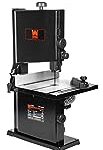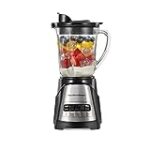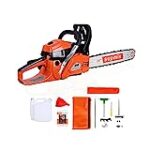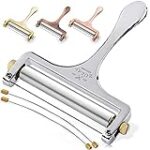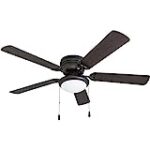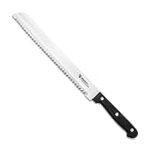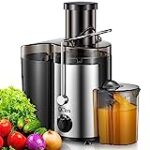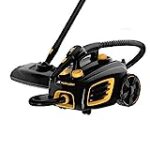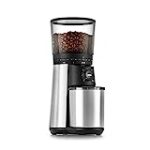🌅 Introduction
Welcome to our comprehensive chop saws buying guide! Whether you’re a professional carpenter or a DIY enthusiast, finding the perfect chop saw can make a world of difference in your projects. With so many options available, it can be overwhelming to choose the right one. Fear not, as we’re here to simplify the process for you. In this guide, we’ll explore the top features to consider when purchasing a chop saw, highlighting durability, power, and versatility. So, let’s dive in and help you find the ideal chop saw that will effortlessly meet your cutting needs!
🏆 Our Top 5
- LARGE TABLE SAW 10 INCH : Metabo HPT's compound miter saw offers better material support with its vice clamping system to secure the workpiece. This single-bevel table saw 10 inch is your ticket to fast and precise cuts, perfect for all your professional or DIY projects.
- PORTABLE DESIGN: The compound miter saw from Metabo HPT is lightweight, at only 24.2lbs. Our portable miter saw is easy to maneuver. The thumb-actuated positive stops allow for quick miter adjustments. 10" miter saw blade included
- POWER SAW FOR PRECISE WOODWORKING: this durable woodworking tool is equipped with a 15 Amp motor to deliver high power for the toughest of cuts, generating a no-load speed of up to 5,000 RPM.
- SAFETY FEATURES: This miter saw includes an electric brake that halts the rotation of the blade within seconds. The built-in blade guard protection and horizontal handle ensure safe cutting.
- VERSATILE AND PRECISE CUTS: Our power saw features a 0-52 degree miter angle range to the left and right for increased flexibility. The bevel range is 0-45 degrees to the left with adjustable bevel stops for precision cuts.
- Stainless-steel miter detent plate of 12-inch miter saw blade comes with 14 positive stops
- The mitre saw features the precise miter system and machined base fence support
- Tall sliding fence of DEWALT miter saw supports 5-1/2-inch base vertically
- Bevels 0 degree - 48degree to the left and 0 degree- 3degree to the right. Tool height-15 inch
- 2-inch x 8-inch dimensional lumber cross cut capacity at 90 degree and 2-inch x 6-inch dimensional lumber at 45 degree
- 15 Amp, 3,800 Rpm Motor With Replaceable Brushes Provides Power And Durability For The Chop Saw
- Quick-Release Material Clamp Of The Metal Chop Saw Allows For Easy Material Cutting And Removal
- Cutting Fence With Miter Adjustment Of The Metal Cutting Saw Allows Up To 45 Degree Angles To Be Cut
- Spark Deflector Provides Safety And Clear Line Of Sight For Cutting
- Integrated CUTLINE Blade Positioning System provides adjustment free cut line indication for better accuracy and visibility for the 12-inch miter saw blade
- XPS technology uses an LED to project light down either side of the blade, creating a shadow on the cutline once the saw arm is lowered
- Super-efficient dust collection system of DEWALT miter saw captures over 75% of dust generated
- Tall sliding fences support crown molding up to 7-1/2-inch nested and base molding up to 6-3/4-inch vertically against the fence while easily sliding out of the way for bevel cuts
- Exclusive back fence design cuts up to 2x14 dimensional lumber at 90 degree and 2x10 at 45 degree
- No Wobble More Accurate: Compared with traditional ones, our abrasive chop saw adopts a thicker vise with wave patterns for increased friction and added clamping tightness. Our saw blade clamping is processed by multiple special processes, which fits better with the saw blades and wobbles less when cutting and can better achieve the cutting effect you want.
- Constant Cutting Performance: Our 80-tooth saw blade can withstand large grinding pressure, drastically reduce the chance of segment breakage, and is especially suitable for fine grinding and cutting with high smoothness and long service life.
- 0-45° for Angled Cuts: Make angle cuts effortlessly. 45-degree adjustable fence helps you adjust the angle of materials at any time according to your cutting needs. Compared with traditional devices, our Tool-less Cut-Off Saw does not need a wrench to adjust. Instead, gently turn the adjustment device to change the angle easily.
- Secure Operation: The protective spark guard can completely wrap around the saw blade when lifting to avoid injuries from chipping or splashing debris during cutting, better protecting your security.
- Widely Used: This 14-inch abrasive cutting saw is a metal-cutting solution built for various shapes of steel bars, rebar, angle iron, aluminum, etc. Our cutting saws can be widely used in construction sites, production workshops, decoration industries, etc.
🤔 How to choose?
1. Power and Motor Strength
When choosing a chop saw, one of the most important factors to consider is the power and motor strength. The power of the saw will determine its ability to cut through different materials with ease. Look for a chop saw with a high horsepower rating, as this will ensure that it can handle even the toughest cutting tasks. A powerful motor will also help to reduce the risk of the saw bogging down or overheating during extended use.
2. Blade Size and Type
The blade size and type are also crucial considerations when selecting a chop saw. The blade size will determine the maximum cutting capacity of the saw, so it’s important to choose a size that suits your needs. Additionally, different blades are designed for cutting specific materials, such as wood, metal, or masonry. Make sure to select a chop saw that is compatible with the type of materials you will be working with most frequently.
3. Cutting Capacity and Accuracy
The cutting capacity and accuracy of a chop saw are essential for achieving precise and clean cuts. Look for a saw with a wide cutting capacity, allowing you to tackle a variety of projects. Additionally, features such as a laser guide or adjustable fence can greatly enhance the accuracy of your cuts. These features can help you achieve professional-looking results, even if you are a beginner.
4. Durability and Safety Features
Durability is another crucial factor to consider when choosing a chop saw. Look for a saw that is made from high-quality materials and has a sturdy construction. This will ensure that the saw can withstand heavy use and last for years to come. Additionally, safety features such as a blade guard and a safety switch are essential for protecting yourself and preventing accidents. Always prioritize safety when selecting a chop saw.
5. Portability and Ease of Use
If you plan on using your chop saw in different locations or need to transport it frequently, portability is an important consideration. Look for a saw that is lightweight and compact, making it easy to carry and store. Additionally, features such as a comfortable handle and easy blade change system can greatly enhance the overall user experience. Consider your specific needs and preferences when evaluating the portability and ease of use of different chop saw models.
In conclusion, when choosing a chop saw, it’s important to consider factors such as power and motor strength, blade size and type, cutting capacity and accuracy, durability and safety features, as well as portability and ease of use. By carefully evaluating these factors, you can select a chop saw that meets your specific needs and allows you to achieve professional-quality results in your woodworking or construction projects.
💡 What to Look for in a chop saws?
1. Blade Size and Type
When looking for a chop saw, one of the most important factors to consider is the blade size and type. The blade size determines the maximum cutting capacity of the saw, so it’s crucial to choose a size that suits your needs.
A larger blade size, such as 14 inches, allows for deeper cuts and is ideal for cutting thicker materials like metal pipes or large pieces of lumber. On the other hand, a smaller blade size, like 10 inches, may be more suitable for lighter-duty tasks or precision cuts.
Additionally, the type of blade you choose will depend on the material you plan to cut. For example, if you primarily work with wood, a general-purpose blade with carbide teeth would be a good choice. However, if you frequently cut through metal, a blade specifically designed for metal cutting, such as one with a high-speed steel tip, would be more appropriate.
2. Power and Motor
The power and motor of a chop saw are crucial for its performance and efficiency. The power of the saw is measured in amps, and a higher amp rating generally indicates a more powerful motor.
A powerful motor not only allows for smoother and faster cuts but also ensures that the saw can handle tougher materials without bogging down. It’s important to choose a chop saw with enough power to meet your cutting needs.
For example, if you frequently work with hardwood or thick metal, a chop saw with a motor rating of at least 15 amps would be recommended. However, if you mainly work with softer materials or require more portability, a lower amp rating may be sufficient.
3. Safety Features
Safety should always be a top priority when using power tools, and chop saws are no exception. Look for chop saws that come with essential safety features to protect yourself and prevent accidents.
One important safety feature to consider is a blade guard. A blade guard covers the blade when it’s not in use, reducing the risk of accidental contact and potential injuries. Some chop saws also come with a spindle lock, which allows for easier and safer blade changes.
Another safety feature to look for is a sturdy and stable base. A chop saw with a solid base provides better stability during cutting, reducing the risk of the saw tipping over or vibrating excessively. Additionally, some models may have a built-in clamping system to secure the workpiece firmly in place, further enhancing safety.
In conclusion, when searching for a chop saw, it’s essential to consider the blade size and type, power and motor, as well as safety features. By carefully evaluating these factors, you can choose a chop saw that meets your specific cutting needs while ensuring a safe and efficient working environment.
🔍 How we picked?
1. Researching the Market
When it comes to buying a chop saw, it’s essential to do your research and understand the market. With so many options available, it can be overwhelming to choose the right one for your needs. That’s why we took the time to thoroughly research and analyze the market to provide you with the best options available.
During our research, we considered various factors such as the power, blade size, cutting capacity, and durability of each chop saw. We also looked at customer reviews and ratings to gauge the overall satisfaction of users. By doing so, we were able to narrow down our selection to the top chop saws that meet our high standards.
2. Evaluating Performance and Features
Performance and features are crucial when selecting a chop saw. We understand that you need a tool that can deliver precise and efficient cuts, whether you’re working on a DIY project or a professional job. That’s why we carefully evaluated the performance and features of each chop saw on our list.
We tested the power and cutting capacity of each saw to ensure they could handle a variety of materials, from wood to metal. We also examined the stability and accuracy of the saws, as well as the ease of use and safety features they offered. By considering these factors, we were able to identify the top-performing chop saws that provide exceptional results.
3. Considering Price and Value
Price is always a significant factor when making a purchase, and we understand that you want to get the best value for your money. That’s why we carefully considered the price and value of each chop saw on our list.
We compared the prices of the chop saws with their performance, features, and durability to determine if they offered good value for the price. We also took into account any additional accessories or warranties included with the saws. By doing so, we were able to identify the chop saws that offer the best combination of quality and affordability.
In conclusion, our selection process involved thorough market research, evaluating performance and features, and considering price and value. We believe that by following these steps, we have identified the top chop saws that will meet your needs and provide you with exceptional results. So, whether you’re a DIY enthusiast or a professional contractor, you can trust our recommendations to help you make an informed decision.
💬 Frequently asked questions about chop saws
1. What is a chop saw and why do I need one?
A chop saw, also known as a miter saw or drop saw, is a powerful tool used for making precise crosscuts in various materials such as wood, metal, and plastic. Whether you are a professional carpenter, a DIY enthusiast, or a hobbyist, a chop saw is an essential tool that can greatly enhance your cutting efficiency and accuracy. With its ability to make angled cuts, bevel cuts, and compound cuts, a chop saw is perfect for a wide range of projects, including framing, molding, and furniture making.
2. What features should I look for in a chop saw?
When choosing a chop saw, there are several key features to consider. Firstly, **blade size** is important as it determines the maximum cutting capacity of the saw. A larger blade size allows for cutting thicker materials. Secondly, **motor power** is crucial for smooth and efficient cutting. Look for a chop saw with a high horsepower motor to ensure it can handle tough materials effortlessly. Additionally, **cutting capacity** is an important factor to consider. Make sure the chop saw can accommodate the size of materials you typically work with. Lastly, **safety features** such as blade guards, electric brakes, and dust collection systems are essential for protecting yourself and maintaining a clean work environment.
3. Should I choose a corded or cordless chop saw?
The choice between a corded or cordless chop saw depends on your specific needs and preferences. A corded chop saw provides a continuous power supply, making it ideal for heavy-duty cutting tasks that require extended operation. On the other hand, a cordless chop saw offers greater portability and flexibility, allowing you to work in areas without access to electrical outlets. However, it’s important to note that cordless chop saws may have slightly less power and shorter battery life compared to their corded counterparts. Consider the nature of your projects and the availability of power sources when making your decision.
4. How do I maintain and care for my chop saw?
Proper maintenance is crucial to ensure the longevity and optimal performance of your chop saw. Regularly **cleaning** the saw, especially the blade and the dust collection system, will prevent debris buildup and maintain cutting accuracy. **Lubricating** the moving parts, such as the pivot points and the blade guard, will keep the saw running smoothly. Additionally, **checking and tightening** all the screws and bolts will prevent any loose parts that may affect the saw’s stability and safety. Lastly, **replacing the blade** when it becomes dull or damaged is essential for achieving clean and precise cuts.
5. Can I use a chop saw for other types of cuts?
While a chop saw is primarily designed for making crosscuts, it can also be used for other types of cuts with the right accessories. For example, by attaching a **dado blade** to the chop saw, you can create dado cuts for joinery purposes. Additionally, with the appropriate **metal-cutting blade**, a chop saw can be used to cut through various metals, expanding its versatility. However, it’s important to ensure that the chop saw is compatible with the specific accessory or blade you intend to use. Always refer to the manufacturer’s guidelines and safety precautions when attempting different types of cuts.
Last update on 2024-07-22 / Affiliate links / Images from Amazon Product Advertising API






